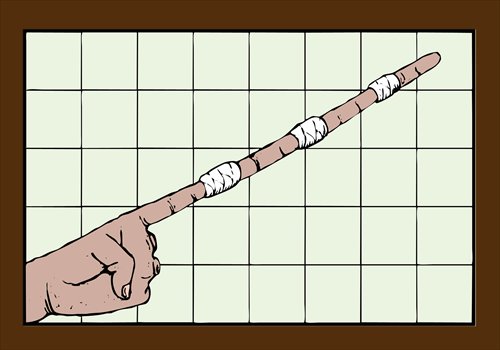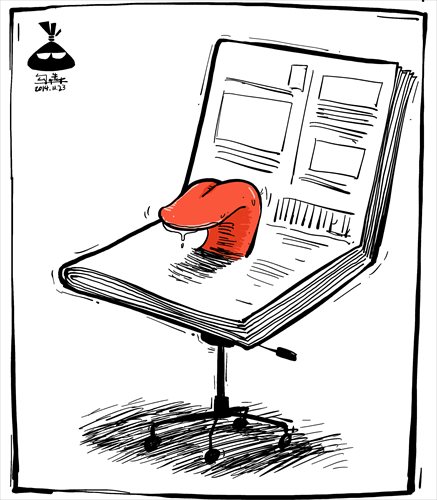Worth a thousand words
Examining the role of caricature in China

Caricature by Xiao Chengsen Photo: Courtesy of Xiao Chengsen

Caricature by Gouben Photo: Courtesy of Gouben
After the terrorist attack at Charlie Hebdo in France, not only have terrorists failed to prevent more caricatures to come out of the satirical magazine, they have ensured the art of caricature has become the center of discussion around the world.
According to Xiao Chengsen - the executive chief editor of Satire and Humor, China's only caricature focused newspaper - a number of Chinese caricaturists have also shown support for their French peers with their drawings, with even Muslim Hui ethnic minority artists showing sympathy to the victims.
"I don't think an attack like this could happen in China. One of the reasons is that editors in China strictly select what caricatures can be published and most authors here regulate themselves to composing within the limits of respect for minority ethnic groups and religious beliefs," said Xiao.
Freedom vs respect
This "self-regulation" was mentioned several times during our interview, as Xiao explained that while freedom of expression is something every author chases after, respect for others demands that some rules not be broken. "We don't usually mock the customs or dress of people from around in the world, and avoid making jokes at the expense of disadvantaged groups. We don't have very clear rules when it comes to this, it is a form of self-regulation that authors should follow." Xiao stressed that caricaturists should never forget their duty to society: find problems in society and point them out.
For Xiao, there are four aspects that make for a good caricature: the ideology represented in the picture, the artistic talent involved, the caricature's timeliness and its ability to rely on pictures to convey meaning. The first two is mainly concerned about how an artist conveys profound meaning in a skillful way, while the latter two refer to how relative to the times a picture is and how well the artist presents his or her ideas through pictures rather than words.
Recently an editorial published on the official WeChat of the Beijing News commentary department stated: "Today, we realized that political caricature has become an 'endangered species' in China."
Xiao disagrees with this assessment. "Since fewer newspapers are printing caricature pages, the public may not see as many works as they did in the past. However, a lot of caricaturists are still working on biting satire with their art."
Xiao also explained that there is still a lot of political caricature in China, for instance ones satirizing current events such as anti-corruption. He pointed that many caricatures drawn today are very profound when it comes to pointing out and mocking the issues in society, which is one of the reasons he feels media outlets are wrong when they say there is no political satire in China.
Art of innuendo
"Caricature is a form of cartoon that can make people contemplate issues. You don't have to present everything in a very simple and direct way," said Xiao. "I am very confident in saying that the way we use caricature to imply things in China is done much better and more skillfully than Western countries."
Gouben, a well-known caricaturist in China, said most of his work about current affairs are still commissioned by media outlets.
"My works are usually published on the commentary pages, sometimes matched with an article. They don't really give me any limitations on what I can present or not, they just tell me about the theme," said Gouben.
According to Gouben, Chinese newspapers are very careful when it comes religion in order to avoid "sensitive problems." "I once painted a caricature about some officials that mistook a pig for a newspaper. The editor told me the next day that the pig I painted had been erased as there was another article on the same page mentioning Muslims - even though my caricature wasn't related to that article at all," Gouben told the Global Times.
According to Xiao, papers are very strict in dealing with any Islamic elements in caricatures. Buddhist elements may influence the fate of a caricature as well. Artist Zhang Jing's caricature Bai, which Xiao believed was a first-prize level work, only received second prize in the China News Awards in 2010 because the work depicted Buddha bowing to a man who donated a lot of money to the temple, which might cause protests among Buddhists. "We are mostly told to avoid promoting any feudal superstitions in our caricatures that include religious elements," explained Gou.
Rise and fall
Manhua, the Chinese term for caricature or cartoon, was first used by writer Zheng Zhenduo, the chief editor of Literature Weekly, to describe a painting by painter Feng Zikai in 1925. Political themes were very popular among early caricature authors back then. After the Marco Polo Bridge Incident in 1937, a wave of caricaturists such as Liao Bingxiong (born Liao Dongsheng), Hua Junwu, Ding Cong and Fang Cheng started to draw a lot of war-themed political caricatures.
After 1949, some State-owned newspapers began hiring caricaturists, mostly having them work on international wars in Asia, Africa and Latin America, domestic conflicts and some works promoting political revolutions. However, things began to change as time went on. In 1957, Liao was labeled as a counter-revolutionary and rightist. Many other caricaturists suffered over the next 10 years.
Things began to change again in 1978 as a more open environment for caricature began to form and more authors began working for newspapers again. During the 1990s, when metropolitan newspapers started to spread around the country, many of them had entire pages dedicated to caricatures, and so caricaturists had even more opportunities for work. "Though a single caricature might not sell for much, many authors started to live a better life," said Xiao.
The decline of print media over the past few years has also hit the market for caricaturists. According to Xiao, some caricaturists have turned to the advertisement industry or become visual designers to get by. On the other side of things, however, social media has begun offering people a brand new platform to publish their own works. Many caricaturists have turned to this new medium, posting their drawings on social media, so they can draw whatever they want.
"The whole atmosphere is much better than before. We can publish something that might not suitable for newspapers, and we can censor ourselves," Gouben told the Global Times.